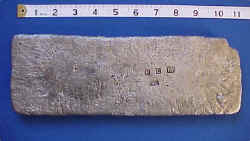I have a close friend who collects shipwreck artifacts. He also, like myself, has a meteorite collection.
Anyway, I just sold a meteorite to my friend, and he threw this unique piece in with it. What a unique piece of history, despite its nondescript appearance. It's called tumbaga. Tumbaga was an alloy of copper and gold used by Mesoamericans to make figurines, etc. Can also be an alloy of gold, copper, or silver. Well, Cortez melted down the Aztec gold, silver, and copper artifacts, made crude ingots of them, called tumbaga bars, and shipped them to Spain, where the Spanish remelted them into their seperate constituants. As a result, tumbaga bars are documented, but none survived once they reached Spain and were remelted.
Until 1993, when a c. 1528 shipwreck was discovered near Grand Bahama Island, and 200 Tumbaga bars were discovered. The only tumbaga bars known. This was the melted down treasure of the Aztecs. Many bars bore the assay mark of a known conquistador and associate of Cortez. Also recovered were small pieces of tumbaga, and that's what this is. An actual piece of the treasure plundered by Cortez and melted down to send to Spain. On one edge, it was filed down by someone at that time checking the silver content. You can also see the copper content from the blue coloration.
Just blown away by owning a melted down piece of the plundered Aztec treasure! My friend actually owns a 2 pound tumbaga ingot with assay mark!
Just heard from my friend. He's stopping by tommorow with his gold and silver bars, and I will photograph them for sure.


Anyway, I just sold a meteorite to my friend, and he threw this unique piece in with it. What a unique piece of history, despite its nondescript appearance. It's called tumbaga. Tumbaga was an alloy of copper and gold used by Mesoamericans to make figurines, etc. Can also be an alloy of gold, copper, or silver. Well, Cortez melted down the Aztec gold, silver, and copper artifacts, made crude ingots of them, called tumbaga bars, and shipped them to Spain, where the Spanish remelted them into their seperate constituants. As a result, tumbaga bars are documented, but none survived once they reached Spain and were remelted.
Until 1993, when a c. 1528 shipwreck was discovered near Grand Bahama Island, and 200 Tumbaga bars were discovered. The only tumbaga bars known. This was the melted down treasure of the Aztecs. Many bars bore the assay mark of a known conquistador and associate of Cortez. Also recovered were small pieces of tumbaga, and that's what this is. An actual piece of the treasure plundered by Cortez and melted down to send to Spain. On one edge, it was filed down by someone at that time checking the silver content. You can also see the copper content from the blue coloration.
Just blown away by owning a melted down piece of the plundered Aztec treasure! My friend actually owns a 2 pound tumbaga ingot with assay mark!
Just heard from my friend. He's stopping by tommorow with his gold and silver bars, and I will photograph them for sure.



Comment